Menu
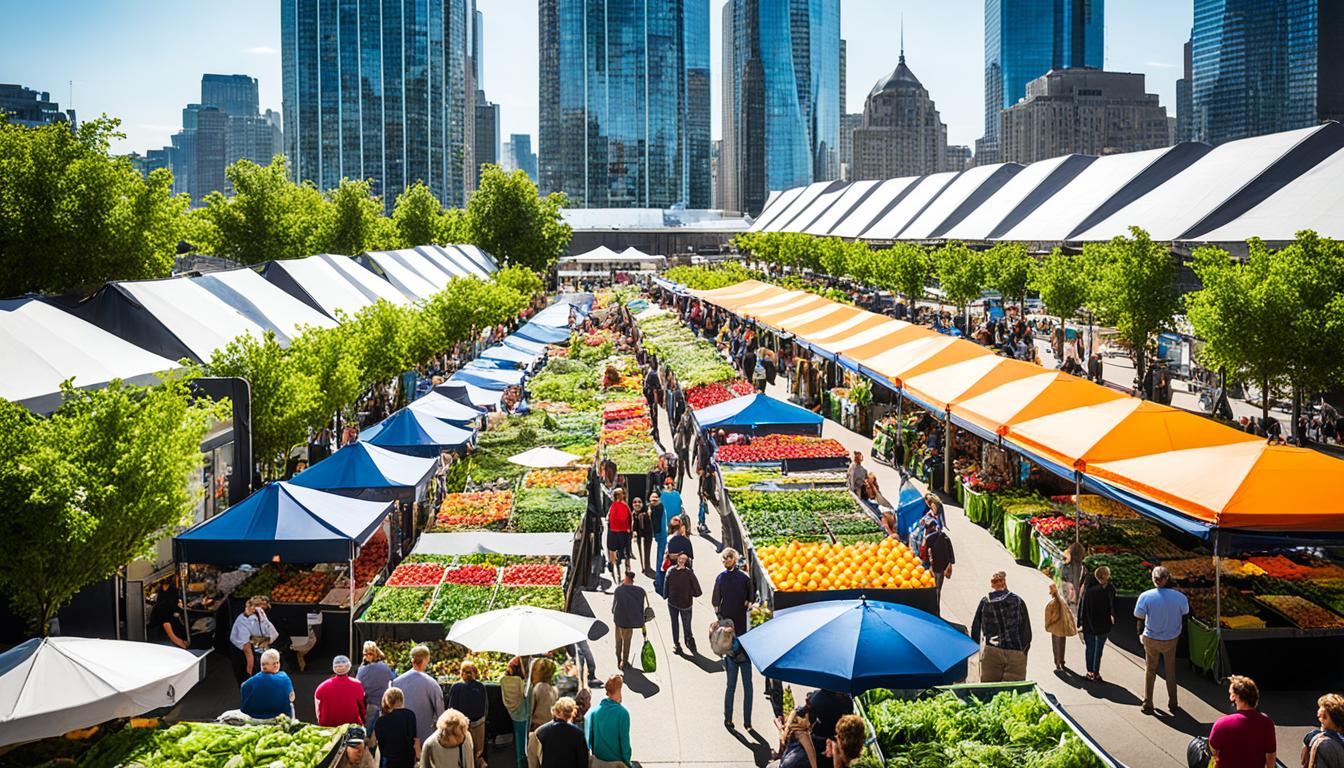
Did you know, less than 10% of U.S. farms sell directly to people? This is even though direct sales make up only 0.3% of all farm income. The urban farming market and sales from sustainable farms are growing. In 2012, 144,530 U.S. farms sold $1.3 billion of fresh food directly to customers. These numbers show how much people like buying directly from farmers.
The urban farming trend is changing how cities get their food. It’s all about being sustainable and using small city spaces efficiently. Urban farming connects local producers with nearby markets. It uses new methods and sells straight to customers. This approach will keep growing, bringing new economic, environmental, and social benefits up to 2031.
Urban farming is all about growing, preparing, and selling food in or near cities. It includes many ways to produce food, like growing it in soil or without soil, on rooftops, or in water. Urban farming is not just for making money. It’s also about improving health and the economy, making food more available, creating jobs, making places prettier, teaching about farming, and helping the environment.
People define urban farming as growing food and other products in or close to cities. There are many ways to do this, such as on the ground, in the city but using water to grow, on roofs, and even raising animals. Most farmers around Maryland focus on growing vegetables, fruit, and flowers. Fewer use the more modern methods, like not using soil.
A survey in 2018 found that urban farmers in Maryland care about different things. They want to feed their community and make a living. Their goals show they think about money, the environment, and people’s lives.
There’s a big want for local and eco-friendly food. Direct sales in farming are becoming more popular because of this. Urban farmers sell their produce directly to people at stands, markets, through CSAs, and to restaurants. Direct selling means farmers can make more money and customers can enjoy fresh food.
Selling directly is also a big thing for farm-focused farmers in cities. But, big farms that use special indoor or water methods sometimes sell to stores or big buyers. A special way some urban farmers sell is by using a ‘sliding scale’. This means they sell expensive crops to some, which allows them to sell other crops cheaper to locals. This helps make food more affordable and creates jobs while keeping the community together. Urban farming is getting more attention because of the many good things it does for people and the planet.
The urban farming industry is growing fast and looks set to grow more. People everywhere are focusing on ways to farm that help the planet. This means the market for urban farming is ready to keep getting bigger.

The urban farming market size reached an amazing USD 139,064.22 million in 2022. Its growth stays strong at 7.88% per year through 2028. Modern farming methods in cities and a push for eco-friendly practices are key reasons for this.
By 2028, the urban farming market size is expected to hit USD 219,151.95 million. This jump would mostly come from using more high-tech farm solutions. Technologies like vertical farms, hydroponics, and AI in farming are set to drive this growth.
Here’s a quick look at some important financial figures and market trends:
| Year | Net Farm Income (Billion USD) | Net Cash Farm Income (Billion USD) | Farm Sector Equity (Trillion USD) |
|---|---|---|---|
| 2022 | $185.5 | $202.3 | $3.57 |
| 2024 | $116.1 | $121.7 | $3.74 |
While some numbers, such as net farm income, might go down in a few years, the future still looks bright. By 2024, the farm sector’s overall financial health is set to improve. This shows the strong and promising nature of urban farming even as economic challenges come and go.
The urban farming market is led by companies that are changing urban agriculture’s future. They use new ways and green methods to grow. Thus, they are boosting sales and eco-friendly habits in the city.
Many firms are leading in urban farming, each helping the industry grow:
These leaders push the urban farming market with new ideas and selling direct. They have grown by 15% every year for the last five years. It’s why the market could hit USD 219,151.95 million by 2028.
The market focuses a lot on food, which is the biggest share. These companies work from growing crops to selling them. This is not just about money. It’s also about improving how we grow food sustainably. They set a high standard for the whole world to follow.
Urban farming innovations are changing city agriculture. They use smart methods to make the most of limited space. These techniques are for people who care about the environment. They want farming that is kind to the earth.
This includes aquaponics, hydroponics, and vertical farming. Each one has special advantages. They help farming that is good for the planet to grow.
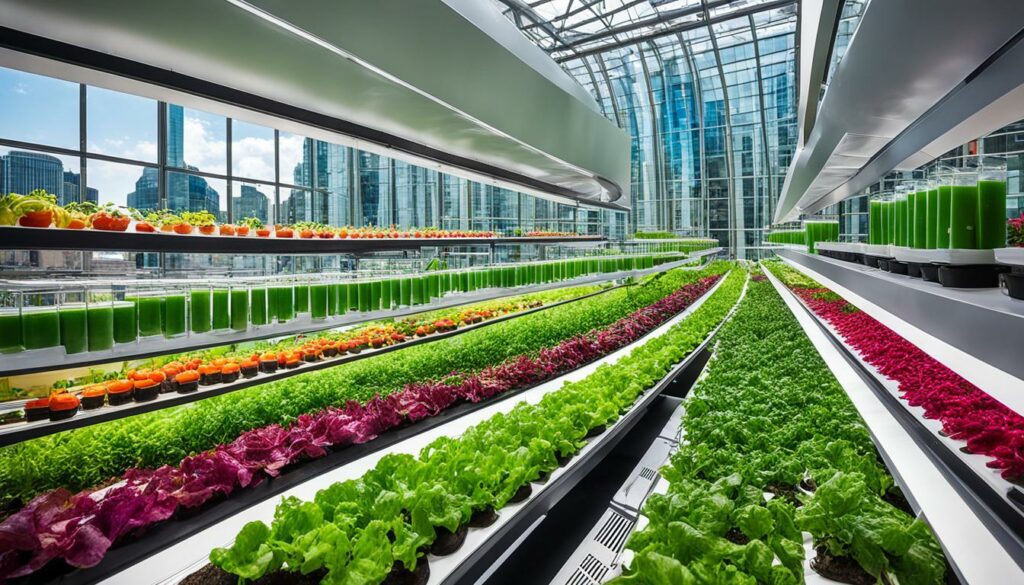
Aquaponics create a win-win for fish and plants. It’s when fish waste feeds the plants. In return, the plants clean the water for the fish. This way, nothing goes to waste.
In cities, aquaponics is a game-changer. It lets urban areas produce lots of food in small spaces. For example, the Dubuque project shows how powerful aquaponics systems can be. They’re changing how we see farming in cities.
Hydroponics is about growing plants without soil. Instead, they grow in water full of nutrients. This method is perfect for cities. It uses space very efficiently.
Places like the Far Rockaway Educational Complex are leading the way. Their hydroponics farm supports 500 schools. It’s a great example of how hydroponics can help in many ways. For one, it saves a lot of water compared to traditional farming.
Vertical farming stacks crops up high. It turns a little space into a lot of growing room. With this system, you can do so much more on the same patch of ground.
For instance, the Nixa School District is planning something big. They’re adding 125 tall growing towers through a grant. This will make more homegrown food and help the environment. Plus, you can farm all year round this way.
Using these new techniques, city farming is ready to feed more people. We can do it while taking good care of the earth.
In cities, urban farming is key to making agriculture less harmful to our planet. It uses new and responsible ways to grow food in cities. This not only saves resources but also boosts plant and animal diversity. Plus, it cuts down on the gases that cause climate change.
By growing food in cities, we cut down the distance it travels to reach us. This reduces the pollution from transporting food. It helps our cities become part of a food system that’s better for the planet. Now, urban farms provide about 15% of all the food we eat.
Urban farms also grow a wide range of plants, which helps local wildlife thrive. Cities like Cleveland and Kansas City have changed their laws to support these green projects. This shows that cities can grow and protect nature at the same time.
Innovative technologies are changing how we farm in cities for the better. Things like LED grow lights and systems that reuse water are leading a new wave of urban agriculture. These tools are making food production in cities both efficient and environmentally friendly.
Cities like Houston are teaching people how to use these new technologies properly. The Hope Farms centre, for example, offers a 12-week course. It teaches future farmers how to use the best methods and technology for the planet. This kind of education is crucial for making urban farms productive without harming the environment.
Making a good living from urban farming takes smart business choices. Urban farmers who market their produce well can earn as much as £50,000 a year from a small plot. But running an urban farm is hard work. It needs a lot of time, about 30 to 60 hours every week.
In the end, adopting eco-friendly farming and smart technologies in cities isn’t just a fashion, it’s essential for the Earth’s future.
Urban farming is changing the way local economies work. It uses fresh, locally grown food to boost the economy. By selling this food directly to people in the area, it helps the economy grow sustainably.
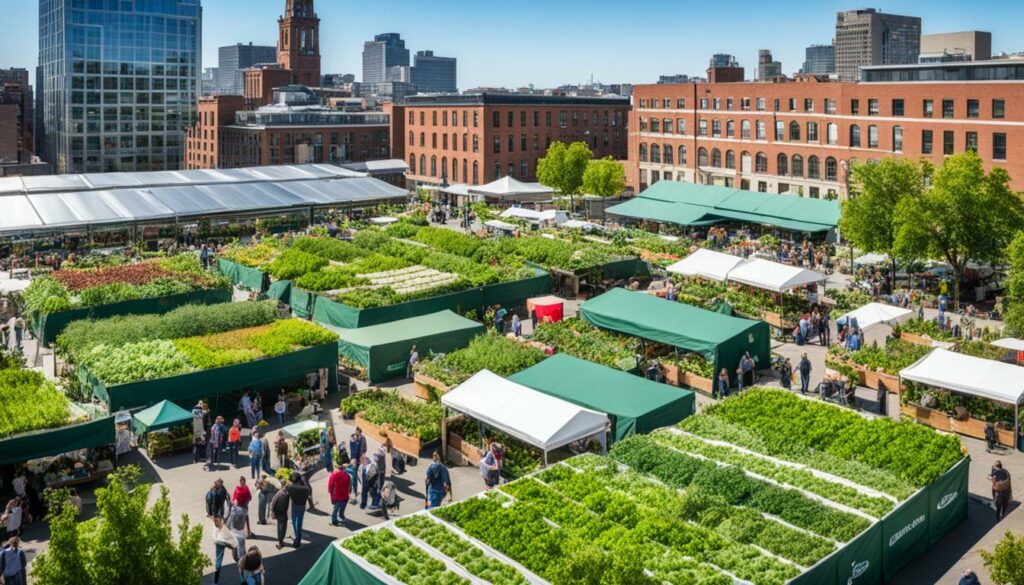
Urban farming doesn’t just grow food. It also makes new jobs and supports local shops, helping the economy. About 13% of Americans deal with not having enough food. Urban farming steps up to tackle this by providing jobs and teaching skills.
Getting into urban farming helps the whole community. It gets young people involved and moving, making them healthier. Community gardens also bring people together. This makes everyone feel safer and helps lower crime.
Selling local food cuts down on how much people spend on groceries. It makes healthy food more affordable for those with lower incomes. But the benefits don’t stop there. Urban gardens also make the area more attractive and bring in visitors, which helps the economy.
Urban farming does face some tough problems, like the high cost of starting and keeping up farms. There may not be a lot of space, and big rules can get in the way. But groups working together and help from the government can overcome these issues. For instance, the Urban Agriculture Act of 2016 looks to give financial help and improve city spaces.
| Challenges | Solutions |
|---|---|
| High setup costs | Government subsidies and grants |
| Limited space | Innovative farming techniques like vertical farming |
| Soil contamination | Hydroponics and aquaponics |
| Regulatory hurdles | Advocacy and policy reforms |
Dealing with these hurdles can let urban farming shine. The food sales give people access to healthy meals. Plus, they make the local economy stronger. Urban farming is becoming more and more important for creating a successful economy.
Consumer trends show more people want local produce. They care about fresh, quality food. The farm-to-table movement is becoming popular. It means getting food straight from local farms and cities. People now look for clear and eco-friendly options when they buy food.
A detailed survey found some interesting facts:
| Aspect | Percentage |
|---|---|
| Increase in fresh fruit consumption over the past 5 years | 75% |
| Higher vegetable consumption compared to 5 years ago | 78% |
| Wider variety of fresh vegetables purchased | 81% |
| Respondents expecting higher quality at farmers’ markets | 98.5% |
| Participants perceiving lower prices at farmers’ markets | 56% |
More people are choosing local produce. Nearly everyone surveyed had bought from farmers’ markets. They say the biggest reason is the quality and freshness of the food.
87% think the food at farmers’ markets is excellent. This shows how good local farmers are at what they do.
The farm-to-table movement is doing well. It means people prefer food that’s good for the planet. 81% now buy more types of fresh vegetables than they did five years ago. Farmers’ markets are key for finding clean, clear products.
Although not everyone picks organic food, more organic food sells each year. This is good news for the earth and for people’s health. The market for organic produce is growing, showing a shift to healthier food.
City farming is also growing and helping meet the demand for fresh food. It’s good for the city and gets people more involved in choosing where their food comes from.
Technology is changing how food is grown in cities. It’s making farming more efficient and sustainable. Urban farmers use smart techniques and collect data to produce food better.

Techniques like vertical farming are making a big difference. AeroFarms in Newark uses aeroponics to grow food with very little water. In Paris, Agricool grows strawberries using 90% less water.
Systems that control the climate automatically are also key. Gotham Greens uses them to grow fresh food all year, no matter the weather. This reduces the farm’s reliance on the right weather conditions.
Data analysis helps farmers make better decisions in cities. In the US, over 200 AI businesses are helping farms succeed. They use AI to watch over plants, predict harvests, and manage resources better.
Using data to farm precisely can save resources. Bowery Farming in New York does this to grow more while using less water and energy. BitGrange teaches kids about farming with advanced technology, showing the wide impact of these techniques.
Farming without soil, like aeroponics, is becoming more popular. It’s proving to be very efficient. As technology gets more involved, farming in cities will keep improving.
Urban farming is very different from farming in the countryside. It faces obstacles like limited space and managing water. Also, it’s hard to run farms in crowded cities.
Lack of space is a big issue for urban farmers. They must use every square foot well. Choosing the right crops matters a lot. It helps urban farmers meet market demand.
Another challenge is getting enough water. Urban areas often have less water. Yet, urban farming is important for food security. So, smart water use is key.
Urban farmers work hard to beat these challenges. They focus on smart marketing. Knowing the 4Ps of marketing is critical. This means working on product, price, place, and promoting it well.
Looking at what their competitors do is also crucial. It helps urban farmers stay ahead. They learn from others and keep improving to do well in the market.
Urban farming direct sales are proving to be a win-win for both farmers and buyers. The Farmer-to-Consumer Direct Marketing Act of 1976 kick-started this movement. It became even easier in 1977 in California for farmers to sell their fresh goods straight to the public.
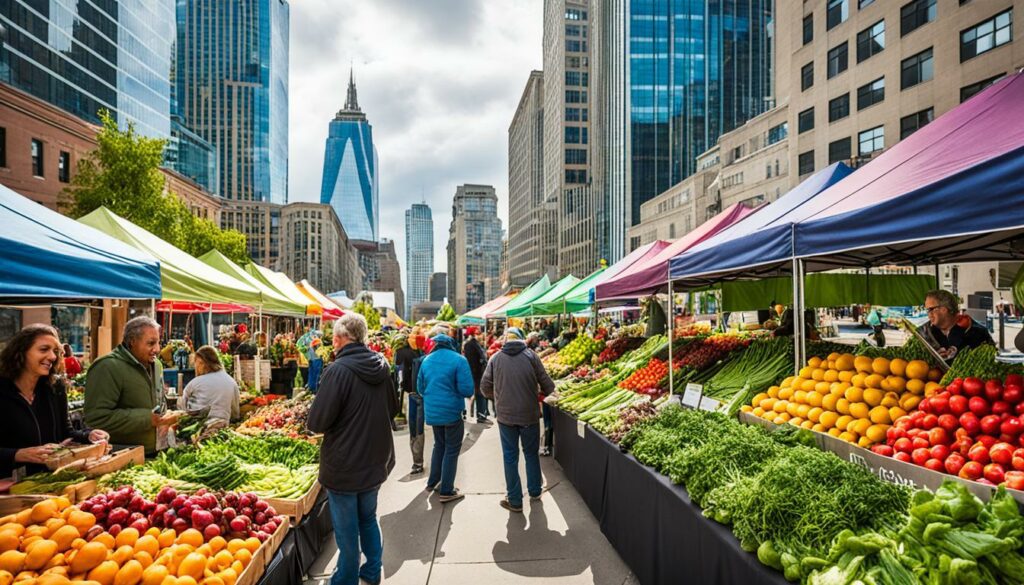
This approach lets farmers bypass the middlemen and sell directly to stores and markets. This way, they make more money by following simpler rules. It includes selling through schemes like CSA, providing a steady income.
Also, farm-to-school and similar schemes help keep farmers busy throughout the year. They help cut down on the costs of packing, shipping, and selling their goods.
In California, people love shopping at farmers’ markets because they know they’ll get top-quality produce. The UC Sustainable Agriculture Research and Education Program checks how well these sorts of local food programs work.
Below is a table with key figures on the rise of direct to consumer sales:
| Statistic | Value |
|---|---|
| Direct sales by farmers to consumers (2007) | 0.4% of total farm sector sales |
| Increase in U.S. farms selling directly to consumers (1997-2007) | 104.7% |
| Value growth of direct sales (1997-2007) | 47.6% |
| Total value of direct sales in 2007 | $1.2 billion |
| Percentage of U.S. farms engaged in direct sales (2007) | 6% |
| Average direct sales value for metropolitan county farms | $10,987 |
| Average direct sales value for adjacent rural county farms | $6,767 |
| Average direct sales value for remote rural county farms | $6,090 |
| Direct sales income for small farms (annual sales under $50,000) | 85% of all farms with income from direct sales, averaging $3,200 annually |
| Direct sales for medium and large farms | $40,000 annually, representing 11% of their total sales (2007) |
Surprisingly, 40% of farmers who sell directly to consumers are new to the field. Almost half of veggie farms, along with one-sixth of fruit farms, prefer selling direct.
Around the world, Latin American farmers are also jumping on the direct sales bandwagon. Many sell at farmers’ markets or through CSAs. During crises, like the recent pandemic, these methods have shown great value to 85% of these families.
Direct sales make a direct link between farmers and buyers, guaranteeing fresh, local produce. This strengthens the community and economy, showing the power of buying local.
Urban farming has created new ways to farm in cities, breaking old rules. Exploring Brooklyn Grange Farm and Freight Farms shows how well it can work. These projects change empty city spaces into green life, helping communities and the planet.
Brooklyn Grange Farm is a leading example of urban farming achievement. It started in 2010 and is now a big rooftop farm covering 5.6 acres in New York City. This farm grows over 50,000 pounds of organic fruits and vegetables every year.
Using rooftop space for farming is not just smart; it’s very effective. It tackles environmental issues, makes food locally available, and supports city wildlife. Brooklyn Grange’s accomplishment shows how much we can gain from urban farming.
Freight Farms takes farming to another level by using hydroponics in shipping containers. Since 2010, it has changed how we think about farming in cities, offering a way to farm all year, regardless of the weather. Their system lets people and businesses grow fresh food in the heart of cities.
This farming method is both creative and eco-friendly. By using old shipping containers, Freight Farms makes the most of space and cuts down on waste. Hydroponics also save a lot of water compared to usual farming. This approach transforms urban areas into places where you can easily find and enjoy fresh, local food.
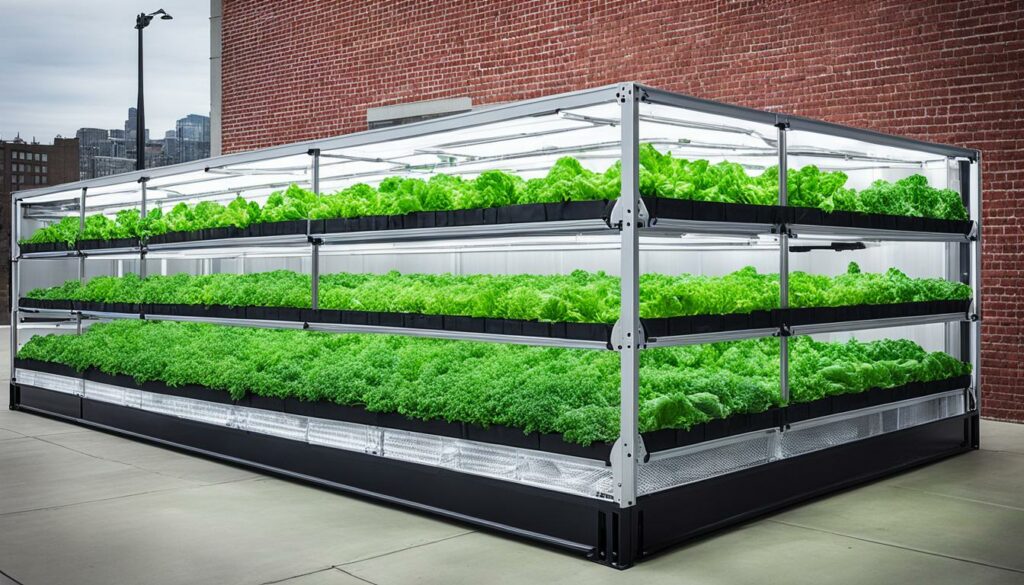
| Statistic | Value |
|---|---|
| Established | 2010 |
| Annual Produce Output | 50,000 pounds (Brooklyn Grange) |
| Key Feature | Hydroponics in Shipping Containers (Freight Farms) |
| Impact | Enhanced Food Security and Sustainability |
Looking at Brooklyn Grange and Freight Farms shows the many paths to urban farming success. Brooklyn Grange turns city roofs into green spaces, while Freight Farms’ use of hydroponics teaches us about flexibility and sustainability. Both these stories prove urban farming is a great choice for our cities today.
Urban farming is growing fast thanks to a focus on sustainability and local food. A big reason for this is the support from the government and the good agricultural policies they have put in place.
To help urban farming, a strong set of rules is needed. Government support means these rules help, not hinder, urban agriculture. For example, Spokane City’s RA zone in Vinegar Flats lets people farm and sell their goods.
By giving subsidies, the initial costs for urban farmers are lower. This helps them start without as much worry about money. These government perks also push for new ideas and green ways of farming. Olympia’s Urban Farm Park is a great success story, showing how communities can come together with the government’s support.
Many projects offer training and job skills within local areas. Urban farms turn empty spaces into community spots. They help make streets safer.
The policies also tackle food access and health challenges. Studies show poorer and certain ethnic neighbourhoods have fewer supermarkets. Better access means healthier eating and less health problems.
In the next few years, I see some big changes happening in future urban farming trends. The urban farming market is now worth a lot. By 2028, it could reach an even higher value. This shows there’s a lot of room for growth and new ideas.
Urban farming is set to get more tech-savvy and innovative. Because more people want food grown nearby, there will be lots of new farms. About 65% of these farms are quite new, showing there’s a chance for new starters to bring fresh ideas to the field.
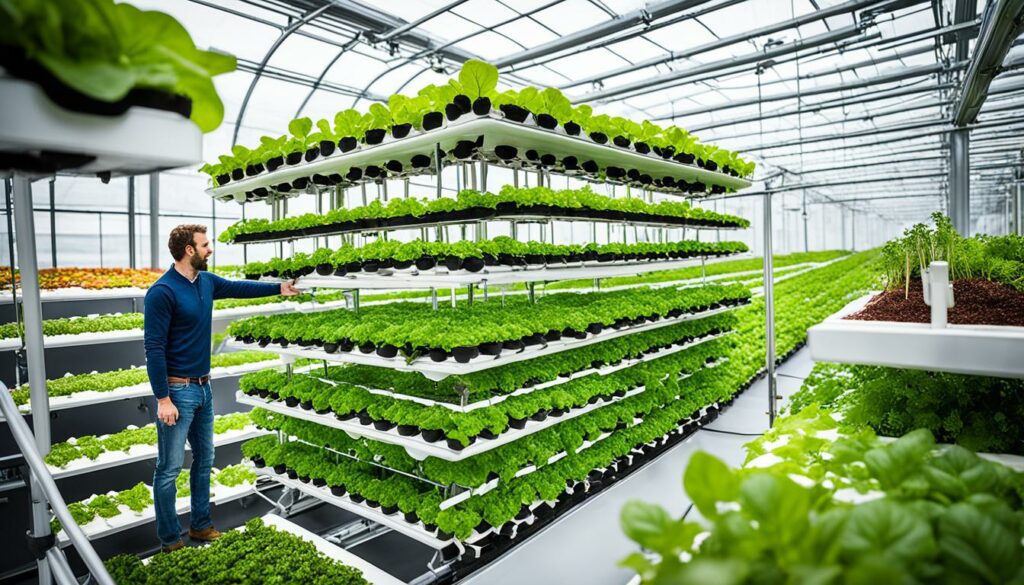
Big companies like Bowery Farming, BrightFarms, and Freight Farms are leading the way in making urban agriculture better. This will lead to more growth in places like North America, Europe, and Asia-Pacific. Different types of urban farming, such as for commercial use, communities, and home gardens, will also become more popular.
Technological advancements are here to stay. Things like vertical farming and hydroponics keep getting better. They help produce more food using fewer resources. Using AI and data will make farms work smarter and greener.
Projects that bring communities together are very important too. For instance, in Bangkok, people used social media to create 54 greenhouse farms. This kind of work can help make sure cities have enough food and are eco-friendly.
Urban farming is growing quickly. It shows a bright future for city living by making it more sustainable. This helps improve food security and boost the economy. Already, more than half the world’s people live in cities, and this number is set to go up. By 2050, nearly 7 out of 10 people will be living in urban areas.
In the US, where most people live in cities, there’s an abundant resource: empty spaces. For example, the Phoenix Metropolitan Area in Arizona has over 67,000 vacant areas. These spots are perfect for urban farming activities.
Urban farming mainly focuses on special crops full of nutrients. These foods meet the rising demand for local and healthy items. Selling products straight to consumers is a success. It has improved what people eat and broadened their food choices. Though some think urban farm products are too expensive, many see the benefits. They think it’s safer and healthier.
Not many farms engage directly with their customers, but those that do gain a lot. Urban farmers who sell directly make more money and build strong ties with buyers. Yet, there are challenges, like using too much fertiliser and legal risks. However, supporting schemes like selling to schools, community farming, and farm-to-table efforts show a big shift in urban farming. As these approaches improve, urban farming not only helps make food but is crucial for how we’ll live in cities in the future.
The current value of the urban farming market is USD 139,064.22 million. It’s projected to grow by 7.88% annually until 2028. By then, it could reach USD 219,151.95 million.
Urban farming brings new jobs and supports local shops. Although starting can be expensive, community efforts and government help boost the benefits.
Urban farming uses aquaponics, hydroponics, and vertical farming. These methods help use space and resources wisely. This makes farming in cities more productive and sustainable.
Leading companies in urban farming are Freight Farms, Brooklyn Grange Farm, and Square Roots. They focus on sustainability and selling directly to the public.
Technology is key in urban farming. It uses smart methods and data to grow more efficiently. This includes controlling climate, monitoring plants, and using farming precision.
Urban farming is sustainable. It uses LED lights, recycles water, and more eco-friendly tech. These help lower pollution and boost nature in cities.
Urban farming sells directly to customers. This supports buying local and offers fresh, local food. It’s part of the farm-to-table buzz for consumers.
Urban farmers deal with space limits, getting water, and city farming issues. It’s key to solve these for farming in the city to grow and last.
Brooklyn Grange Farm and Freight Farms are great urban farming examples. They’ve turned city spots into blooming farms, helping the community and the environment.
Governments aid urban farming with rules, money, and bonuses. This support kicks off farming in the city and encourages new ideas.
Urban farming’s future is bright with more tech, eco-friendly trends, and community work. These new ways will make city farming safer and better for the planet.